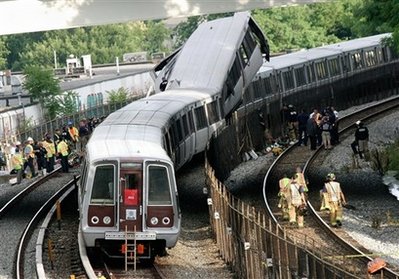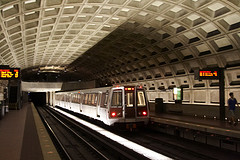The Washington Post’s Coverage: A federal investigation has identified pervasive flaws in rail safety at Metro and severe inadequacies in the agency responsible for oversight. Findings released Thursday call for widespread changes in how the nation’s second-busiest subway system is supervised and managed.
The sternly worded report, prepared by the Federal Transit Administration and presented Thursday to Washington area members of Congress, was the first in-depth look at Metro’s safety program, FTA Administrator Peter Rogoff said. It revealed deep-rooted deficiencies at the transit agency and its independent oversight committee, highlighting vulnerabilities in the systems that are supposed to safeguard passengers and workers, he said.
Rogoff said the safety performance of the Washington system was worse than others of similar size. He said the findings were a symptom of a much deeper problem, extending from executive leadership down to the most junior employee, and he urged the incoming Metro general manager to use the report as a “road map” for the “overarching safety problem.” Click here to read the Washington Post article.
The FTA’s audit resulted in 21 findings and recommendations: 11 findings and recommendations for TOC and 10 findings and recommendations to WMATA.
I have to agree with this excerpt from a post by David Alpert on one of my favorite local blogs – Greater Greater Washington:
The most disappointing piece to me is why it took press attention and FTA oversight to identify, explain, and fix these issues. WMATA could have formulated and publicized its own report explaining how the safety structure was deficient and suggesting ways it would fix them on its own. It didn’t. After the Post discovered and publicized the lapses, WMATA’s statements instead nitpicked specific wording from TOC Chair Eric Madison to try to claim there wasn’t a problem at all.
WMATA needs to own up to these things, not just respond to the FTA’s report and have meetings but actually start coming clean to riders. There are undoubtedly some points the FTA missed; WMATA should proactively suggest those as well. As for the TOC, they have a solemn responsibility to ensure safety, and should take whatever steps necessary without regret, whether that’s breaking procedure and going directly to top managers or the Board, or talking to the press and shouting from the rooftops when something is wrong.

Summary List of Findings and Recommendations
Findings to the Tri-State Oversight Committee (TOC):
- Assess the level of resources necessary from each jurisdiction (District of Columbia, Maryland and Virginia) to meet TOC’s responsibilities. Use the results of this assessment to establish resource commitments from each jurisdiction to TOC for the next three calendar years. Resources should be committed and onboard before the beginning of the next Federal audit cycle.
- Evaluate the technical and professional skills that TOC representatives need to effectively carry out their oversight duties. To the extent that TOC representatives do not currently possess these skills, ensure training is provided as soon as practicable to each TOC member.
- Determine the best method to respond quickly and professionally, as WMATA safety situations arise and require coordinated action. Consider whether full-time TOC positions can be vested with decision-making authority to act in specific safety situations with WMATA.
- Identify and formalize a mechanism to ensure that critical unresolved WMATA safety concerns identified by TOC members are elevated to the highest levels of each TOC jurisdictional agency and WMATA for immediate action.
- Require WMATA to complete a timely, thorough, and competent review and update of WMATA’s Safety Rules and Procedures Manual. This review and update must reflect actual current practices and needed improvements identified by TOC and by FTA in this audit report.
- Require WMATA to develop (and TOC to review and approve) an internal WMATA safety audit recovery plan for calendar year 2010 and calendar year 2011. Before WMATA develops this plan, TOC should sponsor a meeting with WMATA’s Safety Department, Quality Department, and Executive Leadership Team to explain the internal safety audit program requirements and TOC’s expectations regarding WMATA’s internal safety audit recovery plan.
- Require WMATA to develop a recovery plan to complete all open accident investigations following procedures established in TOC’s Program Standard, WMATA’s System Safety Program Plan and WMATA’s Accident Investigation Procedures.
- Document the Corrective Action Plan Technical Review process in TOC’s Program Standard and Procedures and WMATA’s System Safety Program Plan.
- Work with WMATA to ensure that there is a process in place for evaluating Corrective Action Plans (CAP) alternatives that may be necessary as a result of capital and operating program resource limitations.
- Require WMATA to develop and implement a comprehensive and system-wide hazard management program (as required by 49 CFR Part 659.31).
- Require WMATA to strictly adhere to the annual certification of compliance with its System Safety Program Plan (as specified in 49 CFR 659.43), including identifying areas where WMATA is not in compliance with its System Safety Program Plan as well as specific actions WMATA is taking to achieve compliance.
Recommendations to the Washington Metropolitan Area Transit Authority (WMATA):
- Conduct an assessment to identify the resources and expertise necessary for the Safety Department to carry out the activities specified in WMATA’s System Safety Program Plan and Safety Rules and Procedures Manual.
- Use the results of the assessment to ensure adequate staffing levels and expertise within the Safety Department.
- Increase the Safety Department’s access to operating and maintenance information and reports to ensure that this information is being analyzed for potential impacts on the safety of WMATA.
- Develop an internal process to require the communication of safety-related information across all WMATA departments, including the impacts of budget reductions and resource constraints on the performance of safety-related maintenance activities and requirements.
- Define and implement the process for the top Safety Department position to communicate safety priorities to the General Manager in a timely and consistent manner.
- Identify the technical skills required to perform system-wide hazard analysis (as required in 49 CFR Part 659 and TOC’s Program Standard). To the extent that WMATA Safety Department staff does not currently possess the needed skills, provide training as soon as practicable.
- Update the WMATA System Safety Program Plan (specifically Procedure #2.1/0 and Section 6) to develop a hazard management process that ensures that all WMATA departments participate in an on-going manner.
- Institute a process to ensure that changes in operating rules are analyzed for safety impacts before system-wide implementation. For example, WMATA engineering bulletins are “field tested” before full implementation.
- Finalize the right-of-way protection rules, develop training to implement the new rules and ensure all right-of-way employees and contractors receive this training before accessing the right-of-way.
- Implement the configuration management program described in the WMATA System Safety Program Plan.
You can read the oral statement of the FTA Administrator to the congress here. Below is a copy of the report, which is also available for download at the FTA website.
Editor’s Note: Being a regular user of the system to get around the city, it is a bit scary to read about such safety deficiencies in the system. Hope they get it all fixed and make the riders feel comfortable about getting on the trains. Apart from the safety issues identified, I’d like to add that there is a glaring lack of customer service mentality among some of the Metro train operators. Often these train operators fail to realize that they are hired and paid to provide a SERVICE to the customer who pays through his nose (and also risking his life in certain instances). I am still trying to figure out after almost 8 years why do the operators close the darn doors in such a hurry when there is a flood of people waiting to get in and a flood of people trying to get out at the same time. It is a perennial melee of sorts on the platforms during the rush hours and on game days when our local sports teams play at home. Do these operators even realize that by waiting one extra minute on the platforms at such crowded/high-volume stations will immensely help in getting more customers on the train? And by doing that they don’t have to run half-empty trains and puzzled looking passengers left shaking their heads while waiting for the next train? Oh well, it is a culture that needs to change and I hope it happens with the change in management. Here is
one of my personal experiences with the Metro that elicited an apology from WMATA.
![Reblog this post [with Zemanta]](http://img.zemanta.com/reblog_e.png?x-id=97fd249b-26b6-4015-8b64-6154bb207d08)





![Reblog this post [with Zemanta]](http://img.zemanta.com/reblog_e.png?x-id=97fd249b-26b6-4015-8b64-6154bb207d08)